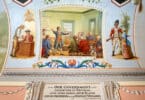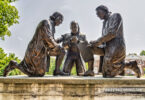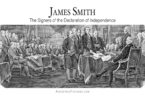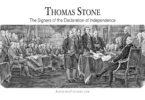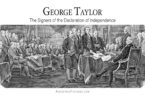Samuel Huntington was born on July 16, 1731 to Nathaniel and Mehetabel Huntington in Windham, Connecticut. The actual location of his birth is now located in Scotland, Connecticut, which broke off from the town of Windham to form its own town in 1857. In fact, the house where he was born is still there, and is located off of Route 14. Samuel was the fourth of ten children born to his parents, but was the first boy, his having four older sisters before he came along.
As compared to other signers of the Declaration of Independence, Samuel had a limited formal education. He attended the common schools in his neighborhood as a young child, and then became self-educated. In the 18th century in the American colonies, being self-educated was considered just as valid of an education as going to school, and one could still enter most skilled professions this way, such as being a doctor, lawyer, or craftsperson, simply by testing well or being an apprentice before starting one’s own practice or shop. In Samuel’s case, he apprenticed to become a cooper when he was sixteen years old, while also continuing to help his father on the family farm. He educated himself using the library of Reverend Ebenezer Devotion (his future father-in-law), and with books, he borrowed from local attorneys.
By studying law on his own, Samuel was able to make a more lucrative career for himself as a lawyer, rather than becoming a cooper. He studied for and took the bar exam, and was admitted to the bar after passing the exam in 1754. After becoming a lawyer, he moved to Norwich, Connecticut, and opened his own law practice there. He married the Reverend Ebenezer Devotion’s daughter, Martha, in 1761. They were married for forty years, until she passed away in 1794. While the couple did not have children of their own together, they took in Samuel’s orphaned nephew and niece after his brother, the Reverend Joseph Huntington, passed away. The couple raised these children, Samuel and Frances, as their own.
Samuel served a brief term as a local selectman, and then began a political career in a true sense of the word in 1764, when he was elected as a representative from Norwich to the lower house of the Connecticut colonial assembly. Samuel stayed in that office until 1774. In 1775, Samuel was elected to the upper house of the Connecticut colonial assembly, which was called the Governor’s Council. He continued to serve in this office, and was re-elected to it in 1784.
In addition to these positions, Samuel was appointed the King’s attorney for Connecticut in 1768. In 1773, he was appointed to the supreme court of the colony of Connecticut, which was called the Supreme Court of Errors at the time. He served as Chief Justice of this court from 1784 until 1787.
Samuel was a vocal critic of British policies in America, including the Coercive Acts. Because of his outspokenness on behalf of the American colonies in their disputes with Great Britain, he was elected from the Connecticut colonial assembly to be a delegate to the Second Continental Congress in 1776. He arrived there in January of 1776, along with Roger Sherman and Oliver Wolcott, as the Connecticut delegation to the Congress, which was located in Philadelphia, Pennsylvania. While at the Congress, he voted in favor of the Declaration of Independence, and later signed it.
Samuel continued to serve at the Congress, going there again from 1778 to 1781, and again in 1783. He suffered a case of smallpox while there, but recovered.
Though he was not well-educated or a terrific public speaker, Samuel had a reputation for hard work without complaint and for having a calm demeanor in most any situation. These qualities earned him respect from his fellow Congressional delegates. Because of this excellent reputation at the Congress, Samuel was elected to be President of the Continental Congress when the previous president John Jay went to be Minister to Spain in September of 1779. While the position of President of the Continental Congress was mostly ceremonial, Samuel did have to handle a lot of correspondence and signed official documents in this role. He also used his position as president to urge colonial legislatures to enact levies to support the men fighting the American Revolution, supplying them with weapons and money. The Articles of Confederation, which was the first governing document of the new nation before the Constitution, was also ratified and enacted while he was President of the Continental Congress.
Samuel resigned his position as President of the Continental Congress due to unreliable health in July of 1781 and went home to Connecticut. Connecticut selected him to go back to the Congress the next year, but his health was still uncertain, and he had become a judge again by then, so these things kept him from accepting the position. He did go back to the Congress as a delegate in 1783, during which time the Americans won the Revolution, and the Treaty of Paris was signed with Great Britain, ending the war.
The same year that the Treaty of Paris was signed, Samuel was elected as a member of the American Philosophical Society.
After serving on the Continental Congress, Samuel built a mansion in 1785, and that same year was elected as Lieutenant Governor of the new state of Connecticut. The next year, he was elected Governor of Connecticut. While serving as Lieutenant Governor, Samuel also kept his position as the Chief Justice of the Connecticut Supreme Court, but gave that judicial position up when he became Governor of the state. Samuel continued to be elected Governor of Connecticut each year after that, for the rest of his life. During his time as Governor, he was the leader of the Connecticut Convention that was called to ratify the new Constitution as a replacement for the Articles of Confederation as the governing document of the United States.
Samuel passed away at his home, while still serving as Governor of Connecticut, on January 5, 1796. He was buried next to his behind their mansion in Norwich, in the Old Norwichtown Cemetery. Both Samuel and Martha were disinterred while a project to restore and renovate his tomb was being undertaken in 2003. Samuel and Martha were re-interred there together in a formal ceremony in November of 2003.


